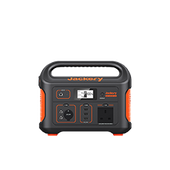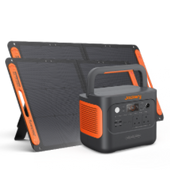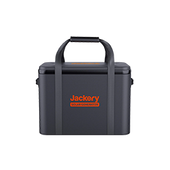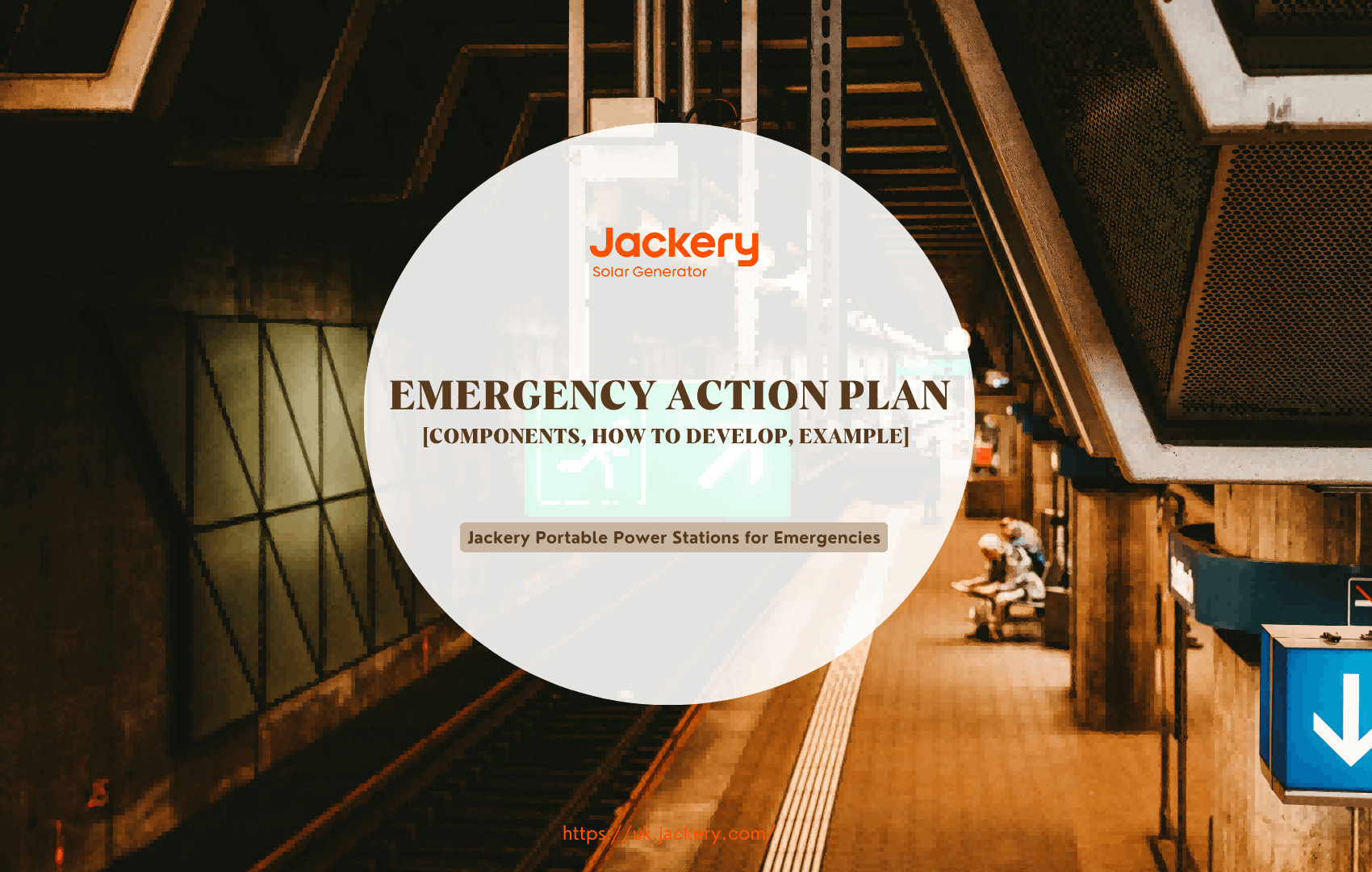Don't worry if you still feel insecure about something that hasn't happened yet; that's normal. The actions taken in the first moments after a crisis are often critical.
So, are you ready to start executing your emergency action plan? In many cases, emergencies can be prevented or mitigated by proactively planning and assessing existing and potential security risks that threaten your team.
This article explains the meaning, importance, key components, and who should use an emergency action plan. Most importantly, it details the development and testing of an emergency action plan. Electricity is vital in some emergencies, such as power outages, blackouts, or natural disasters, so a Jackery Portable Power Station can help you charge essential appliances in an emergency to some degree.
|
Key Takeaways: |
|
An emergency action plan is a procedure that outlines how to respond and react in an emergency. It can help relevant personnel respond to unpredictable emergencies in a shorter period. Emergency action plans usually include emergency evacuation procedures, responsibilities, contact information, rescue, and other factors. Businesses, families, schools, etc., especially need to develop emergency action plans to deal with emergencies. There are eight steps to develop a comprehensive emergency action plan. To ensure its effectiveness, testing it is an essential link. We recommend you use an emergency generator, such as Jackery Explorer 1000 Plus or 1000 v2, to charge essential devices, like your phones, radios, flashlights, and more. |
What Is an Emergency Action Plan?
Generally, an emergency action plan refers to the preparations and precautions made to protect people's lives and property in an emergency. It is a procedure that outlines how to respond and react in an emergency. It usually outlines the critical steps within the first few minutes of a disaster, whether it is an artificial disaster, a natural disaster, or any emergency that threatens life and the environment.
Therefore, a reasonable emergency action plan can help people deal with emergencies and reduce unnecessary injuries and losses. It includes preventive measures for potential disasters, emergency response strategies, and evacuation and recovery plans after disasters. In short, an emergency action plan is a preventive measure and a comprehensive guarantee for people's safety.
Emergency action plans are developed for many types of emergencies. Therefore. Different emergencies require different plans, and the specific details depend on the situation. In addition, some emergencies that people usually encounter in their daily lives include:
- Fire
- Flood
- Hurricane
- Earthquake
- Tornado
- Severe weather
- Power outage
- War
- Terrorist attack

Why Is An Emergency Action Plan So Important?
If disaster strikes, are you ready? Emergencies are often unpredictable and unavoidable, but with a reasonable emergency action plan, you can quickly respond and take appropriate measures. Therefore, the actions taken at the beginning of an emergency may be crucial to survival.
Improve the Efficiency of Emergency Response
The emergency action plan clarifies the specific response steps and processes when facing an emergency. For example, it specifies the responsibilities of various departments and personnel to ensure that response measures can be deployed quickly and orderly in an emergency. Therefore, the emergency action plan helps avoid confusion and improve emergency response efficiency.
Reduce Risks and Losses
A pre-made emergency action plan can eliminate potential dangers and reduce losses. In addition, an effective emergency action plan means saving lives. For example, an emergency action plan for fire can help people quickly escape from the fire scene and reduce casualties.
Enhance Teamwork
The coordination mechanism and process formulated by the emergency action plan ensure that organisations and individuals can work together efficiently and improve overall response capabilities. Therefore, an effective emergency action plan can encourage organisations and individuals to cooperate better and jointly respond to crises when facing uncontrollable situations.
Key Components of An Emergency Action Plan
While each emergency may require unique actions, general action plan elements can help keep the workplace safe and orderly during an emergency. Through these components, an emergency action plan ensures that emergency response is carried out quickly and minimises losses and injuries. Emergency action plans typically include the following key components:

Basic Situation Overview: The primary situation overview mainly involves a basic description of the emergency, the areas and people that may be affected, and the type of incident and potential consequences.
Emergency Evacuation Procedures: At the heart of any solid and effective emergency action plan is a set of well-defined emergency evacuation procedures, as some emergencies may require personnel to evacuate and evacuate.
Emergency evacuation procedures typically outline the steps individuals should take to safely evacuate a specific area during a crisis, including evacuation routes, places of refuge, and particular actions to minimise risks. In addition, special attention needs to be paid to the evacuation arrangements of specific groups, such as older people, children, and the injured.
Emergency Duties: In an emergency, some employees may be required to perform specific operational duties, such as shutting down gas, electrical systems, and special equipment. The emergency action plan should clarify roles (from first responders to evacuation coordinators and communications liaisons) and ensure everyone knows their responsibilities, takes appropriate action, and coordinates with each other.
Emergency Contact Information: The emergency action plan should contain a detailed list of internal and external emergency contacts. Ensuring that the contact information is always available and up-to-date ensures that the emergency can be reported quickly and effectively in an emergency.
Internal contacts may include designated personnel responsible for coordination, medical personnel and security personnel, while external contacts may involve paramedics, emergency services, local authorities and relevant utility services.
Emergency Rescue: Public resources (such as fire departments or medical institutions) usually perform rescue and medical duties in emergencies. However, when preparing an emergency action plan, you can be sure that there are people who can provide emergency rescue before the emergency services arrive, for example, people with first aid or CPR certification.
Laws and Regulations: Of course, the emergency action plan must also be cautiously treated in terms of laws, regulations, and relevant policies. Please comply with the applicable laws, rules and policy requirements to formulate and approve the emergency action plan. In addition, please actively coordinate with government and external emergency response organisations when testing and implementing the emergency action plan.
Who Needs An Emergency Action Plan?
An emergency action plan ensures that everyone knows possible dangers and understands how to respond to an unexpected situation. So, who needs an emergency action plan?
While every person and organization may face emergencies, the following groups of people are particularly in need of an emergency action plan:
Business: Generally, companies need to develop a detailed emergency action plan to guarantee the safety of employees, customers, and property in emergencies. Small and large organisations can benefit from creating an emergency action plan.
Family: Every family should have a basic emergency action plan to deal with natural disasters or sudden emergencies. The plan should include emergency contact information, escape routes, and necessary supplies.
School: Schools must develop corresponding emergency action plans to ensure the safety of students and faculty in emergencies. The plan should include response measures for emergencies like fires and earthquakes and conduct regular drills.
High-risk Industries: High-risk industries such as mining, construction, and chemical industries must develop detailed emergency action plans to deal with possible production safety accidents. The emergency action plan for high-risk industries should include accident warning, emergency response, personnel evacuation and rescue measures, etc.
How To Develop An Emergency Action Plan?
Developing an emergency action plan is integral to any organization, business, or community facing a potential emergency. A comprehensive emergency action plan can help you respond in an orderly manner and minimise losses when faced with an emergency. Here are the steps you need to take to develop a comprehensive emergency action plan:

Step 1: Clear Objectives
The first step in developing an emergency action plan is to clarify its objectives. The goals of an emergency action plan are generally to protect personnel safety and reduce property losses.
Step 2: Risk Assessment
A comprehensive risk assessment is required before developing an emergency action plan. Risk assessments should be conducted not only for current safety hazards but also for potential safety hazards. The risk assessment of an emergency action plan generally includes possible natural disasters (such as earthquakes and floods), artificial accidents (such as fires and chemical leaks), and other potential emergencies.
Step 2: Develop Detailed Emergency Procedures
Detailed emergency procedures should include the steps and measures to be taken in various emergencies. Therefore, detailed emergency procedures should include:
- Effective alarm and notification mechanisms to ensure that all relevant personnel can be notified quickly in an emergency.
- Determine the contraindications for allocating emergency supplies and equipment to ensure the required resources can be quickly obtained in an emergency.
- Develop detailed evacuation routes to ensure personnel can evacuate the dangerous area safely and orderly.
- Mark an emergency shelter according to the specific emergency.
Step 4: Improve Emergency Responsibilities
Improving the specific emergency responsibilities of relevant personnel is a vital part of the emergency action plan, which should include emergency command, logistics support, medical rescue, safe evacuation, etc.
In addition, training opportunities can be developed and organised for relevant personnel to ensure they all understand the correct procedures. Professional training may help reduce the risks of specific emergencies.
Step 5: Emergency Equipment and Tools
When developing emergency action plans for different situations, please list the emergency equipment and tools needed. You may already have some necessary supplies, so please take inventory and find out where the emergency action plan is unprepared.
The emergency equipment and tools needed for an emergency action plan typically include fire extinguishers, automatic fire extinguishing systems, escape ladders, smoke masks, and other personal protective equipment.
Step 6: Evaluation and Exercises
Contact your local emergency service provider to evaluate your emergency action plan, which will give you the most professional advice. Of course, the most effective way to assess your emergency action plan is to conduct an exercise. Exercise can help identify deficiencies in the emergency action plan and improve personnel's practical capabilities and coordination. Conduct an exercise for the corresponding emergency action plan every quarter to simulate evacuations corresponding to potential threats.
Step 7: Emergency Recovery
Emergency recovery is also an essential part of the emergency action plan, which can help organisations resume normal operations as soon as possible and learn lessons from the crisis.
Emergency recovery usually includes post-disaster cleanup and repair work, psychological support for affected personnel, business recovery, and evaluation and improvement of emergency action plans.
Step 8: Update and Improvement
Emergency action plans are not static and usually change with operations, facilities or personnel. Review your emergency action plans at least once a year to ensure they are still applicable. If there are changes, continuous improvements should be made to the emergency action plan based on actual conditions. For example, you may need to update the contact information included in the plan or the evacuation routes affected by the renovation.
If you are still wondering what an emergency action plan is, check the following fire emergency action plan in PDF format.
Check Fire Emergency Action Plan Example >>
Jackery Portable Power Stations for Emergencies
Electricity is vital in some emergencies; for example, you need power to connect with others, check the situation updates, or even charge the flashlights. The portable power station is one of the optimal choices for emergencies since it doesn't have noise or any pollutants, and it is safe to use at home. There are many brands of portable power stations in the UK, and Jackery is one of the best.

Jackery Portable Power Station is equipped with a lithium battery (lithium-ion or LiFePO4 battery) to ensure a consistent and stable power supply. The pure sine wave inverter and MPPT charge controller safeguard it from overcharging or other potential dangers.
Moreover, this power station is user-friendly and necessitates minimal maintenance, rendering it a dependable option for emergencies or blackouts. Here, we recommend Jackery Explorer 1000 Plus and 1000 v2.
Jackery Explorer 1000 Plus
The Explorer 1000 Plus power station boasts an excellent 1264Wh long-lasting LiFePO4 battery and a 2000W full-power pure sine wave inverter, supplying almost all required power. Adding up to three additional battery packs will remarkably increase its capacity to 5kWh.
Adding up to three extra battery packs lets Jackery's exclusive technology boost the Explorer 1000 Plus capacity from 1.26kWh to 5kWh. Moreover, it has a maximum output of 2000W, 20% more than usual 1kWh LFP generators.
A wall charge from 0% to 100% of the battery requires 100 minutes, while solar charging with four SolarSaga 200W panels takes 2 hours. Additionally, the innovative ChargeShield technology and consistent power delivery avoid equipment damage.

- Up to 5kWh expandable capacity for emergencies.
- Full upgraded BMS (battery management system) protections
- Fast wall charging only takes 100 min to reach 100% battery level.
- Long-lasting LFP battery with 4000 charge cycles.
- SMART App control at fingertips.
|
*Review from Our User |
|
Residing where lightning strikes and power outages are common, I required a reliable solution to ensure my work-from-home software consulting business operates seamlessly. The Jackery 1000 Plus has truly made a significant difference. This product is impressively sturdy and compact, fitting seamlessly in my home office (see pic). When the power goes out, it truly makes a difference. I can continue my work as if everything is normal, which is quite impressive. |
Jackery Explorer 1000 v2
The Explorer 1000 v2 Portable Power Station has an impressive 1500W output, 50% greater than earlier models, efficiently supplying power to high-demand appliances in an emergency, such as refrigerators, computers, CPAP machines, and more.
Equipped with USB-A/C connections and dual PD charging up to 100W, it can simultaneously charge numerous devices, rendering it the ideal companion for all your power requirements.
The Emergency Charge Mode, activated via the app, enables the Explorer 1000 v2 Portable Power Station to achieve a full charge in under one hour, providing essential power backup when the battery is depleted. Moreover, charging from 0% to 100% within two hours via an AC wall outlet prolongs battery longevity.
Experience serenity with its nearly silent operation, maintaining noise levels below 22dB while energising your devices. This power station guarantees an uninterrupted power supply.

- Up to 7x Faster¹, full charge in as fast as 1 hour with emergency supercharging ability.
- Ultra durable LiFePO4 battery for 4000 life cycles up to 10 years daily use.
- Whisper-quiet operation under 22dB for peach.
- UPS less than 20ms, seamless power switching, IEC 62040 certified.
- 18% smaller than the old version Explorer 1000 certified.
|
*Review from Our User |
|
When it arrived, I charged it to 100%, and it took less than a couple of hours to plug into an outlet since it came with some charge. I have already tried it with a water kettle and a portable heater set to low. Both units reached approximately 1500 watts individually during testing, primarily to replicate a more comprehensive load scenario. This power station is relatively lightweight, weighing less than 25 lbs, which enhances its portability and versatility for various applications. |
How to Test An Emergency Action Plan?
Emergency action plans ensure they respond quickly and effectively to emergencies, reducing losses and injuries. Testing emergency action plans is an essential link in ensuring their effectiveness.
Regularly organising emergency drills is an essential means of testing emergency action plans. By simulating real scenarios, relevant personnel can become familiar with emergency procedures and improve their practical capabilities.

Set Clear Test Goals
Before testing the emergency action plan, you must understand the current security situation and emergency response capabilities. Set clear test goals, such as verifying the effectiveness of the emergency response process, the feasibility of technical solutions, and personnel readiness.
Set Detailed Test Steps
The emergency action plan's test steps should be detailed and specific, including a detailed description of the emergency response process and the allocation and planning of test tasks. Corresponding checkpoints should be configured during the test process to ensure that each link can achieve the expected results.
|
*Expert Tips for Set Emergency Action Plan Test Steps |
|
Select possible emergencies as test scenarios according to the emergency action plan, such as natural disasters. Simulate an actual emergency in a controlled environment. Execute the response according to the predetermined emergency action plan and record the actual effect of each step. Conduct a comprehensive assessment of the emergency response process, summarise the experience and lessons, and propose improvement measures. |
Test the Effectiveness of the Emergency Response
The emergency response process should include the response process, communication and coordination mechanism, and staffing plan.
Test whether the communication system is unobstructed and whether the information transmission is timely and accurate. Evaluate the on-site handling capabilities, including the response speed of the emergency team.
Test whether team members can clearly define their responsibilities and cooperate efficiently during emergencies. Test the coordination ability of medical rescue.
Test the ability to allocate emergency resources, such as whether the required materials and equipment can be in place in time.
Summary and Improvement
Based on the test results and the experience and lessons of actual emergency events, the content and process of the emergency action plan should be continuously improved and perfected to improve the ability to respond to emergencies.
Emergency Action Plan FAQs
The following are the frequently asked questions about the emergency action plans in the UK:
- What is the biggest challenge in implementing an emergency action plan?
The biggest challenge in implementing an emergency action plan is the need for more communication or the inability to exchange relevant information.
Well-trained personnel with clear roles contribute significantly to the effectiveness of emergency response. If emergency responders can clearly understand their roles and responsibilities from the beginning, a lack of communication can be effectively avoided.
- What is an excellent way to measure the effectiveness of an emergency action plan?
The success and effectiveness of an emergency action plan depend mainly on how quickly it can resume normal operations after a significant incident. Even a short-term disruption to operations can cause considerable losses to businesses, social organisations, etc., so the speed of resuming normal operations after an emergency is a crucial indicator for measuring the effectiveness of an emergency action plan.
- What is a good emergency action plan?
Generally, an excellent emergency action plan should include the following key elements:
- An effective alarm and notification mechanism in the first place
- An evacuation plan covering different locations and situations
- Correct practices to follow when dealing with risks or evacuating
- Contact information in case of an emergency
- A response plan after an incident
- What should a family emergency action plan usually consider?
When making a family emergency action plan, you should consider the following:
- What other ways are there to contact others besides mobile phones or home phones?
- Where should my family and I go if an emergency occurs?
- How can we get to where we are going?
- How can we get electricity and water if amenities are no longer available?
- Prepare an emergency kit containing non-perishable food, identification forms, and medicines.
- Elderly, children, and pets are important parts of a family emergency action plan.
Final Thoughts
Understanding all potential hazards is critical to any emergency action plan because it gives you time to prepare for the impending emergency. The emergency action plan you develop will give everyone involved a clear understanding of what to do in a chaotic situation. Your emergency action plan will be a guiding light that leads everyone to safety when an emergency occurs. Once an emergency is identified, the relevant personnel can act quickly, confidently, and comprehensively according to the emergency action plan to ensure that losses are reduced and personnel are safe.


































































































